unsure if footers exist for garage wall
Hi,
I just moved to a new house a month ago and am in the middle of my second project which is to replace the garage doors & openers and to redo part of the garage floor. The house is located in center of town in Acton, MA. It is a 4BR, 2.5BA colonial with a 2 car under garage built sometime around 1966.
I have a garage door company lined up to install R-16 steel clad doors with Merantec openers (I’m impressed how quiet they are). My mason already ripped up 1/3 of the garage floor which had cracked and settled in various spots thereby causing the door to not close all the way (the gap is about 3″ on each side of the door).
Over the weekend, I was cutting away some of the garage door rails near the floor to ensure that they would not be in the way of the floor. I noticed that there was some rot in the middle wall between the two garage doors. I pulled the plaster away and saw that the sill was completely rotted away and 2-3 inches of the posts were also rotted. Great.
My carpenter is going to come out Saturday morning to see what should be done. I’m guessing is that he’ll rig up some sort of temporary support structure (bunch of 2×4 ganged together to support the top plate, garage header, and support beam before cutting away the sill and the bottom portion of the posts. With the temporary support in place, my mason will be able to pour the floor. Once the floor is in place, I’m guessing that he’ll put 3-4 2×6 PT boards together for a new sill plate and toe nail the posts to them and secure them to the newly poured floor.
My concern has to do with the footing and support wall. If you look at the picture (labelled no_sill_and_maybe_footer_2), you’ll see that there is a little blob of concrete in the middle and two bricks under each 4×4 post. Below the bricks, there is a “slab” about 18 inches wide that runs the length of the garage door wall. I would have expected to see the sill resting on an 8″ wide wall that goes X inches into the ground to rest on the footing. I’m surprised to see that this band of concrete is actually 18 inches (perhaps more) wide. This made me wonder if there’s no footing that down the road, I will have the same problem. I spoke to my mason on the phone to reschedule the pour and he says that this is typical the way they do garage floors. He said that once the wall is supported, he’ll work the floor to be underneath the wall so that my carpenter can attach the new sill plates to the floor.
Anyway, what are your thoughts? Thanks for any and all advice.
–Bill
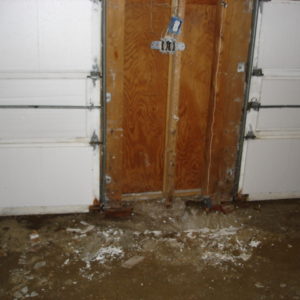
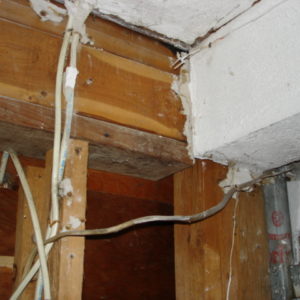
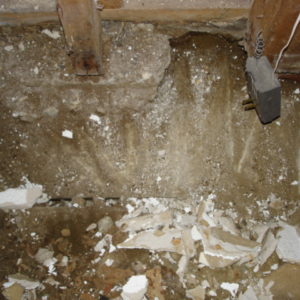
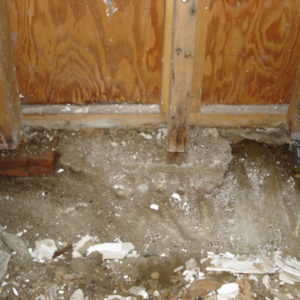
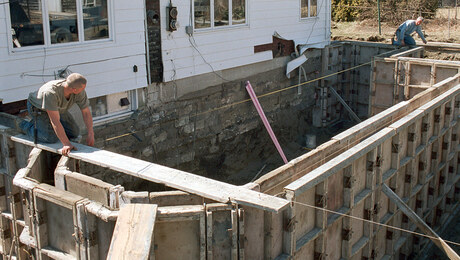



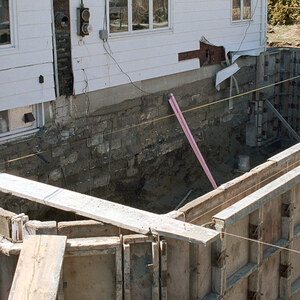













Replies
Greetings gt,
This post, in response to your question, will bump the thread through the 'recent discussion' listing again.
Perhaps it will catch someones attention that can help you with advice.
Cheers
We all dance to a mysterious tune, intoned in the distance by an invisible piper. - Albert Einstein
Thanks Rez.
I had my carpenter looked at it this past weekend. He thought it was strange and it did look like it was a footing. He didn't think it was an issue because it's supporting the gable end of the house and there isn't as much bearing weight there.
His plan is to put a diagonal brace to support the end of the beam temporarily (he didn't think it was needed since that partition wall wasn't supporting anything. The plywood walls on the gable end were what's holding everything up). Cut away the bottom of the middle partition wall to get it out of the way. Once the concrete guy pours a new partial floor, he'll replace the jack studs on the garage door walls with pressure treated wood and put in new pressure treated sills. He's also recommending that I replace the trim at the bottom of the exterior partition wall and around the garage door opening with Azek....especially where it touches the ground to eliminate future concerns with rot.
Seems like a good plan. Now he has to find a time in his busy schedule to fit me in. I might have to do part of it myself (the bracing, and cutting away the sill) so that I can get the concrete guy going again.
View Image
We all dance to a mysterious tune, intoned in the distance by an invisible piper. - Albert Einstein